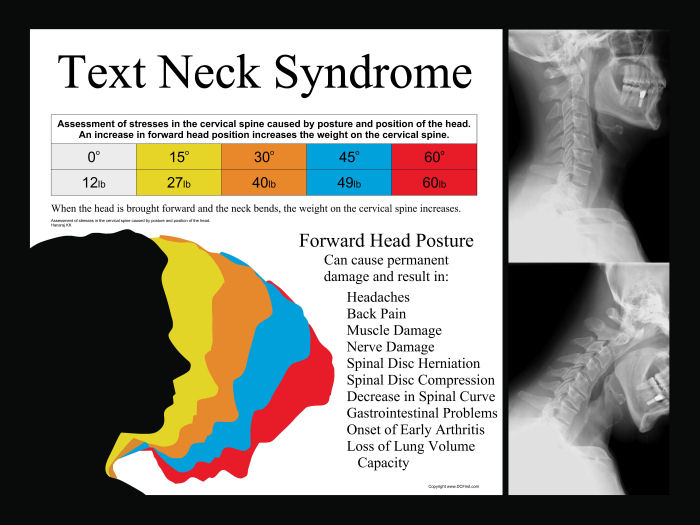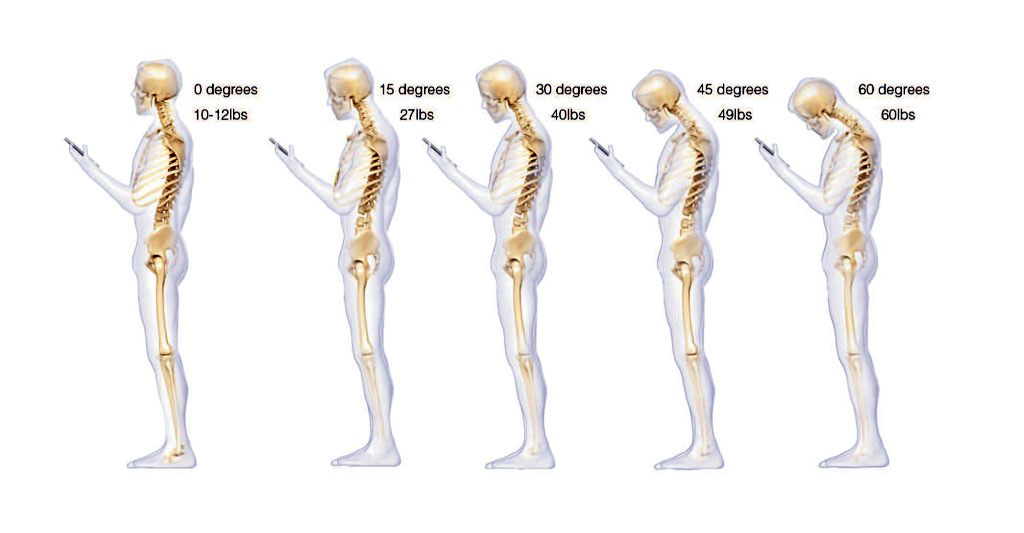Previously, we discussed how repetitive cervical strain, which has been termed “text neck” in recent years, has become more of an issue. Just a few years ago, the phrase “text neck” was virtually unheard of. However, in reality, the issues with sustained and repetitive cervical flexion have been around for a very long time–they have just been given the fancy “text neck” moniker recently.
If we consider how common it is for teens, adolescents, and adults to spend several hours a day on the phone or send several thousand text messages a month, one can imagine that over the course of 20 years, the repetitive strain can lead to changes in the normal curvature of the spine. Beyond the musculoskeletal aches and pains associated with the change in spinal curvature, it can have further implications on lung capacity and create a greater workload on the cardiovascular system. Dr. Bolash of the Cleveland Clinic describes how the impaired lung capacity from sitting in a slumped posture restricts oxygen and causes the heart to work harder to distribute more oxygen-carrying blood through your body.
This is further highlighted when considering how similar forces occur with several other daily activities such as reading, writing, and meal preparation. Ultimately, some of these positions are not avoidable. The point to be made is to be more aware of our postures, avoid positions of undue stress and take proactive steps to strengthen and stabilize the muscles of the cervical spine.
We discussed how looking down while texting can equal upwards of 60 pounds of force to the cervical spine, which would be the equivalent of a 5 gallon jug of water hanging from your neck and then adding a 20 pound car tire hanging from that. (Here’s an abc news report on the issue). So the question now is what can we do to help prevent these degenerative structural changes in our neck due to repetitive overuse of our cellphones?
Let’s start with some of the easier fixes:
- Limit your usage of cellphones and other electronics.
- Bring the cell phone or tablet up to eye level during use; if reading use a book stand to elevate the book to eye level.
- If you are sitting and must keep your phone down low, hinge more at your hips, keep your spine (back and neck) neutral and simply look down with your eyes
- Utilize voice to text technology
- Do strengthening and stretching exercises to target muscles of the cervical spine.
- Visit a physical therapist to implement a more client-centered and extensive treatment plan. Remember that the same rules don’t apply to everyone. Each of us are at a different level of postural awareness, have different muscle imbalances, and varying levels of joint mobility. A physical therapist can help identify the appropriate program for you.
The key is prevention. Technology will continue to improve and make life easier than ever before. When I was in school, the teacher would always say to the class “you won’t have a calculator everywhere you go, so you need to learn how to do this!” Funny how that worked out! 10 years ago, I never would have thought to be able to read a 300 page novel on a 4.5 inch iPhone screen, but the option is now available. Technology will keep changing, its up to us to make sure we use these new conveniences in a safe and comfortable way.


